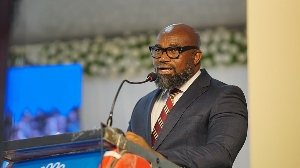- Home - News
- TWI News | TV
- Polls
- Year In Review
- News Archive
- Crime & Punishment
- Politics
- Regional
- Editorial
- Health
- Ghanaians Abroad
- Tabloid
- Africa
- Religion
- Election 2020
- Coronavirus
- News Videos | TV
- Photo Archives
- News Headlines
- Press Release
Business News of Thursday, 7 August 2014
Source: B&FT
Illegal mining attracts cocoa farmers

A large number of people who hitherto were trooping into the cocoa-growing belt of the Brong Ahafo Region to eke a living on cocoa farms are now engaged in illegal mining, an alternative “thriving economic activity” in the Ahafo community.
Settlers predominantly from the three Northern regions who have flooded communities such as Kenyasi, Ntotroso, Hwidiem, Gyedu and other adjoining villages are mostly into illegal mining, also known as “galamsey”. Paradoxically, many of those who used to travel to these areas in times were lured into cocoa farming.
“Because of the ever-increasing challenges confronting the cocoa sector, it’s no longer lucrative enough to attract the needed labour force. We are losing most of our labourers to galamsey while many others are also hesitant to take up cocoa farming,” John Amankwah, Asutifi District Chief Farmer told B&FT in an interview.
He said the situation has compounded the reluctance of indigenous youth who are in search of alternative livelihood activities at the expense of inheriting cocoa cultivation -- the major traditional economic activity in the Ahafo part of the region to help neutralise the aging and fast-dwindling workforce.
According to the International Cocoa Organisation’s forecast, Ghana -- the world’s second-largest producer -- could produce up to 900,000 tonnes of cocoa beans in the upcoming 2014/2015 crop season. But challenges including lack of a substantial labour force could negatively affect productivity rates at the various farms, thereby undermining the target.
The District Chief Farmer said for Ghana to ensure long-term sustainability of cocoa production, government must institute pragmatic measures to subdue the mounting challenges affecting cocoa production.
He mentioned inadequate and inconsistent supply of subsidised inputs, such as fertiliser and pesticides.
“The mass-spraying exercise is no more reliable; subsidised fertilisers are only accessible to a few farmers; and not many have the financial muscle to buy from the open market, leaving many cocoa farms to their fate.
“Notwithstanding our invaluable contribution as the sub-stratum of the cocoa industry, farmers are now the poorest and most vulnerable in the supply chain link. Access to reasonable credit is elusive; we are fast-losing our socio-economic competiveness in society, and this must be a cause of worry for the government,” he lamented.
The cocoa sector can only regain its rightful position to attract the youth if measures are put in place to make cocoa farming more lucrative, Mr. Dankwa added. Averagely, Ghana annually earns about US$2billion from cocoa.










